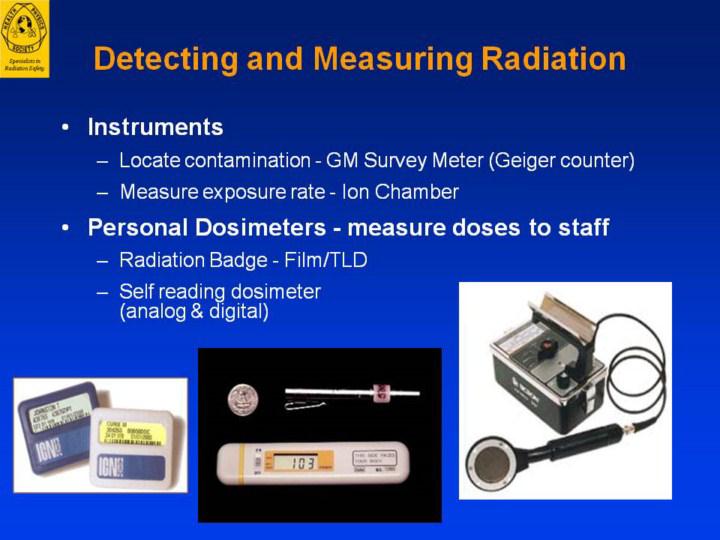| front |1 |2 |3 |4 |5 |6 |7 |8 |9 |10 |11 |12 |13 |14 |15 |16 |17 |18 |19 |20 |21 |22 |23 |24 |25 |26 |27 |28 |29 |30 |31 |32 |33 |34 |35 |36 |37 |38 |39 |40 |41 |42 |43 |44 |45 |46 |47 |48 |49 |50 |review |
 |
Detecting and Measuring Radiation
You
cannot see, smell, taste, feel, or hear radiation, but we have very
sensitive instrumentation to detect it at very low levels. Radiation
monitoring instruments detect the presence of radiation. The radiation
measured is usually expressed as exposure per unit time, using various
units of measure, milliroentgen per hour (mR/hr) and counts per minute
(CPM).
Anything with milli in front of it is SMALL!
The most commonly used instruments to detect the presence of radiation
include:
Geiger-
Mueller Survey Meter.
The Geiger-Mueller (GM) survey meter (also known as a Geiger counter)
will detect low levels of gamma and most beta radiation. The instrument
typically has the capability to distinguish between gamma and most beta
radiation. This instrument is used to quickly determine if a person is
contaminated. GM survey meters are very sensitive and other instruments
may be needed to measure higher levels.
Ionization
Chamber Survey Meter.
This device can accurately measure radiation exposure. These meters
measure from low levels (mR/hr) to higher levels (many R/hr). To find
the dose an individual is receiving, multiply the dose rate by the time
that they are exposed.
Personal
Dosimeters.
These devices measure the cumulative dose of radiation received by
persons wearing them. Film and TLD badges must be analyzed by the
company that supplies them and so the dose received is not typically
known for several days. However, self reading dosimeters allow the
wearer to immediately see the total dose they have received.
|